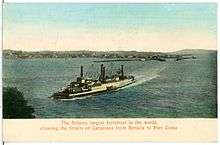Solano (ferry)
The ferry Contra Costa, sister ship to Solano c.1917 | |
| History | |
|---|---|
| Namesake: | Solano County, California |
| Owner: | Central Pacific Railroad |
| Cost: | $350,000 |
| Launched: | 1878 |
| In service: | 1879 |
| Out of service: | 1930 |
| Status: | Scuttled for breakwater c.1931 |
| General characteristics | |
| Type: | Railroad ferry |
| Length: | 425 ft (130 m) |
| Beam: | 116 ft (35 m) |
| Propulsion: | Sidewheels |

The Solano was a large railroad ferry, built as a sidewheel paddleboat that operated across the Carquinez Strait between Benicia and Port Costa in California.
She was built at near the end of Long Wharf. She commenced trials on 24 November 1879 from Meigg's Wharf with 75 selected guests on a trip around Alcatraz and to Benicia. She can travel at about 12 mph, though on the first day of her trial did not exceed 8.[1]
She was constructed and operated by the Central Pacific Railroad to ferry entire trains (up to 48 cars at a time) on the Central Pacific transcontinental line to and from the San Francisco Bay Area. Once in service, the transcontinental railroad was re-routed to the sea level ferry crossing from its original course into the Bay Area via the Altamont Pass. Before her sister ship, Contra Costa, was constructed, Solano was the largest ferryboat ever built.
Solano, named for the county in which Benicia sits, was built in 1878 in Oakland, California. She was 425 feet (130 m) long and 116 feet (35 m) wide and was capable of carrying entire passenger trains or a 48-car freight train and locomotive. She was in service from 1879 to 1930.
Her sister ship, Contra Costa, was built in 1914 and also ran until 1930. She was slightly larger than Solano, and remains the largest rail ferryboat ever built. Contra Costa was named for the county in which Port Costa is located.
By 1927, the two ferries had reached their maximum capacity. On 31 May 1928 the Southern Pacific, successor to the Central Pacific in operations of the ferries, authorized construction of a railroad bridge from Benicia to Martinez just east of Port Costa. The railroad bridge opened in November 1930 and continues to serve the Union Pacific and Amtrak railroads.
Following the opening of the railroad bridge, Solano and Contra Costa were dismantled and sold for scrap. However, what remains of the Solano can still be seen where she was scuttled to create a breakwater in the San Joaquin River near Antioch, California.
External links

- Harris, Robert L. (April 1890). "436. The Railroad Ferry Steamer "Solano"". Transactions of the American Society of Civil Engineers. XXII.
- "Solano Ferry Model". Central Pacific Railroad.
References
- ↑ "The Big Boat". Oakland Tribune. 25 Nov 1879. p. 3. Archived from the original on 4 July 2018. Retrieved 4 July 2018.
Satisfactory Trial Trip around the Bay and to Benicia yesterday...
Coordinates: 38°01′01.92″N 121°48′18″W / 38.0172000°N 121.80500°W